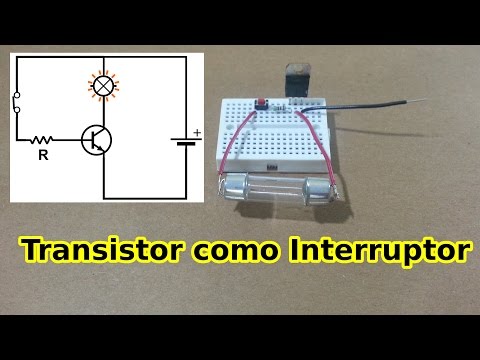Transistor as a switch: Which is the most suitable?
The transistor is one of the most used electronic components today due to its ability to control the flow of electric current. One of the most common applications of the transistor is using it as a switch. However, there are different types of transistors and each of them has specific characteristics that make them more suitable for certain applications. In this article, we will explore the different types of transistors and analyze which one is most suitable for use as a switch in different scenarios.
Discover which transistor is the best to use as a switch in your electronic projects
If you're looking for transistor to use as switch in your electronic projects, it is important that you know what your options are and which one is best for your needs.
The transistors They are electronic components used as switches or signal amplifiers. In the case of using them as switches, they are used to control the flow of current in a circuit.
El transistor Most commonly used as a switch is the field effect transistor o MOSFET. These transistors have low resistance when on and high resistance when off, making them ideal for use as switches.
Other transistor that is used as a switch is the bipolar junction transistor o BJT. These transistors have high gain and are ideal for use in amplification applications, but can also be used as switches.
Regarding the choice between a MOSFET or with a BJT For use as a switch, it depends on the specific needs of your project. If you need a high speed and low power switch, a MOSFET is probably the best option. If you need a high power switch, a BJT is probably the best option.
In short, choose the transistor Suitable for use as a switch in your electronic projects is essential to ensure efficient and safe operation of the circuit. Whether you choose a MOSFET or BJT, be sure to consider the specific needs of your project before making a final decision.
In the world of electronics, there are always options and alternatives that must be considered before making a final decision. The choice of transistor The right fit can significantly affect the performance of your circuit, so it's important to research and compare your options before making a final decision.
Practical guide: How to choose the ideal transistor for your electronic projects
When it comes to designing and building electronic projects, one of the most important decisions you must make is choosing the transistor appropriate. Transistors are essential components in electronics, acting as amplifiers or circuit switches.
The first step in choosing the right transistor is to determine what type of transistor you need. There are three main types of transistors: BJT (bipolar junction transistor), MOSFET (metal-oxide-semiconductor field effect transistor) and IGBTs (insulated gate bipolar transistor).
Once you have determined what type of transistor you need, you should consider the specifications of the transistor, such as the peak current, Maximum tension, greed, maximum power and maximum frequency.
Additionally, you should consider the type of load the transistor will drive, as this may affect the type of transistor you need. For example, if you are controlling an inductive load, such as a motor, you will need a transistor that can handle feedback currents.
Another factor to consider is the operating temperature. When choosing a transistor, you need to make sure that it can operate correctly in the temperature range in which your project will be used.
In summary, to choose the ideal transistor for your electronic projects, you must determine what type of transistor you need, consider the specifications of the transistor, the type of load it will control, and the operating temperature.
Don't forget that the choice of transistor will affect the performance and reliability of your project. So take your time to choose the right transistor and make sure it meets your project requirements.
Now that you know the aspects to take into account when choosing the right transistor, what other tips or recommendations would you add to the selection process? Share your ideas in the comments!
PNP or NPN transistor: Which one to choose and when to use it in your electronic projects?
Transistors are fundamental electronic components in any project. But how do you know which one to choose? PNP or NPN?
First, you must understand that an NPN transistor has two layers of N-type material and one layer of P-type material, while a PNP transistor has two layers of P-type material and one layer of N-type material. The choice will depend on the type of circuit. that you are building.
If the circuit requires current to flow from the base to the emitter, then you should use an NPN transistor. On the other hand, if you need current to flow from the emitter to the base, then you should use a PNP transistor.
One of the advantages of NPN transistors is that they are more common and easier to find, making them cheaper than PNP transistors.
Additionally, their gain is higher, which means they are more sensitive to small signals.
On the other hand, PNP transistors are ideal for circuits that require high current and voltage, and where the polarity is reversed, such as in switching circuits. Additionally, PNP transistors can be more efficient in high-frequency signal amplification applications since they have a higher transition speed and lower noise compared to NPN transistors.
In summary, the choice between a PNP or NPN transistor will depend on the specific needs of your project. It is always important to take into account the characteristics of each one and compare them with the needs of the circuit you are building.
In conclusion, when choosing between a PNP or NPN transistor, it is important to understand the differences between them and consider the specific needs of the circuit in which it will be used. With this information, you will be able to make the right decision to obtain the best performance and efficiency in your electronic project.
Discover the different types of transistors and why the NPN type is the most popular in electronics
Transistors are essential components in modern electronics, and there are different types that are used depending on the needs of each circuit. The three most common types are BJT (Bipolar Junction Transistor), MOSFET (Metal-Oxide-Semiconductor Field-Effect Transistor) and JFET (Junction Field-Effect Transistor) transistors.
The BJT transistor is the most common due to its simplicity, low cost, and versatility. This type of transistor is divided into two subtypes: NPN and PNP. NPN is the most popular due to its ability to amplify signals and control current with a low input signal, making it ideal for low power applications.
The NPN transistor is built with three layers of semiconductor material: a layer of P-type material between two layers of N-type material. The layer of P-type material is called the base region, while the two layers of N-type material are called the emitter region and the collector region. When a current is applied in the base region, a current is created in the collector region, allowing the transistor to act as a switch or amplifier.
The NPN transistor is used in a wide variety of applications, such as audio amplifiers, power supplies, oscillators, and switching circuits. It is also used in the construction of digital logic devices such as microprocessors and microcontrollers.
In summary, the NPN transistor is the most popular type of transistor in electronics due to its simplicity, low cost, and versatility. It is widely used in a variety of low-power applications and is essential in the construction of modern electronic devices.
Electronics is a fascinating and constantly evolving field, and transistors are just a small part of what makes modern technology possible. What do you think will be the next big advance in electronics?
Discover everything about the transistor: its history, operation and detailed diagram
El transistor It is one of the most important electronic components of all time. It was invented in 1947 by scientists William Shockley, John Bardeen and Walter Brattain at Bell Laboratories in the United States.
El operation The transistor is based on the control of electric current through a semiconductor material, which can be P-type or N-type. The transistor is made up of three layers: the base, the collector and the emitter. When a current is applied to the base electrode, this current controls the current that flows between the collector and the emitter.
Transistors are very important in modern electronics, as they are used in a wide variety of electronic devices, from radios and televisions to computers and mobile phones. Transistors are also used in integrated circuits, which are silicon chips that contain millions of transistors.
El detailed scheme of the transistor can be represented by a schematic diagram that shows the three layers of the transistor and the connections between them. This diagram is used to design and analyze circuits that use transistors.
In short, the transistor is a fundamental component of modern electronics that has forever changed the way we live and work. Its operation is based on the ability to control electric current through a semiconductor material and its importance in modern electronics is incalculable.
Would you like to know more about electronics and its components? Don't hesitate to continue researching and discovering everything that technology has to offer!
In conclusion, the choice of the transistor as a switch will depend on the specific needs of the circuit and the load to be controlled. It is important to consider the current and voltage parameters of the transistors to ensure that they are suitable for the application required.
We hope this article has been useful in understanding the characteristics and operation of the transistor as a switch. Don't hesitate to leave us your comments and questions in the section below.
Thank you for reading!




Post Comment